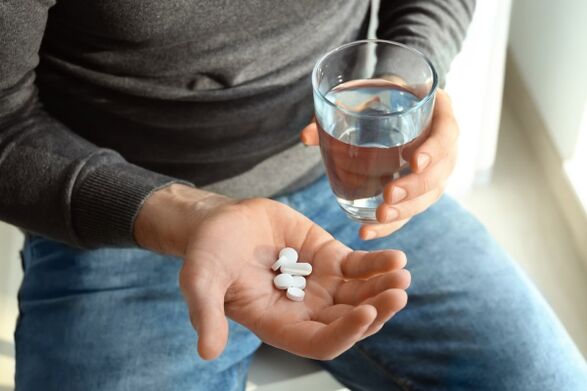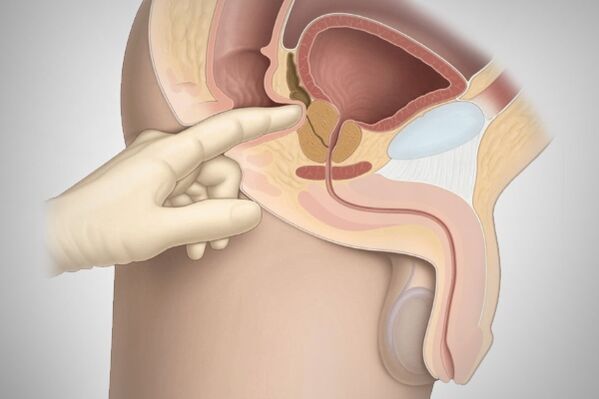Sometimes men face unpleasant diseases such as bacterial prostatitis. In order to start treatment on time, it is important to know what signs can determine the disease and what kind of diagnosis and treatment are needed.
Bacterial prostatitis is an infectious disease of the prostate. Symptoms of the disease include perineal pain, increased body temperature, body poisoning, and other physical signs. This condition may require urgent hospitalization because it may pose a threat to the patient’s health and life.
Forms of bacterial prostatitis
According to the course of the disease and the symptoms, bacterial prostatitis is divided into two forms, acute and chronic.
sharp
The acute form manifests unexpectedly and is accompanied by various unpleasant symptoms. Acute bacterial prostatitis requires immediate medical attention. This pathological process is caused by Escherichia coli, Staphylococcus, and Enterobacter.
It is easy to diagnose acute prostatitis using laboratory tests. Severe symptoms and clinical pictures can make an accurate diagnosis. The use of drugs and physical therapy to treat this form of prostatitis in a complex way.
Chronic
Chronic bacterial prostatitis has pathogens that can be determined through laboratory tests and research. The main pathogens are Neisseria gonorrhoeae, Chlamydia, Ureaplasma, and Mycoplasma. If a man is infected with HIV, the inflammatory process may also be caused by Candida tuberculosis or fungi.
Types of bacterial prostatitis
Bacterial prostatitis is classified according to the type of pathogen:
- Tuberculosis (Kochella);
- Gonorrhea (gonococcus);
- Fungi (various types of fungi);
- Chlamydia (Chlamydia);
- Viruses (pathogens of herpes, human papillomavirus, influenza);
- Mixed (several different infections).
Only under laboratory conditions can it be determined what the pathogen is, because everyone's symptoms are the same.
Causes and risk factors
Bacteria enter the prostate and cause acute or chronic prostatitis. Sexually transmitted diseases can also cause this disease. In some cases, the cause cannot be determined.
PathogenConsider bacterial prostatitis:
- Escherichia coli;
- Klebsiella;
- Proteus
- Enterococcus faecalis;
- Pseudomonas aeruginosa.
possibleMicrobial causeProstatitis is:
- Staphylococcus (saprophytic, golden, epidermal);
- Mycoplasma Genitalia;
- Chlamydia trachomatis;
- Ureaplasma urealyticum;
- Trichomonas.
arriveRisk factorsProstate infection and subsequent inflammatory processes in the form of one or another bacterial prostatitis are:
- Reflux in the prostate (the backflow of urine to the prostate catheter during urination);
- Pelvic injury;
- Unprotected anal sex;
- Urinary tract infection;
- Those with indwelling catheter or intermittent bladder catheterization;
- Transurethral diagnosis and treatment intervention;
- HIV AIDS;
- Past prostate biopsy.
Symptoms of bacterial prostatitis
Usually, the symptoms of bacterial prostatitis are so obvious that it is difficult not to attract attention. Signs of illness include:
- High body temperature (the anus is usually higher than the armpit);
- Fever and chills;
- Difficulty and painful urination, especially at night;
- May cause constipation due to an enlarged prostate;
- Lower body pain (lower back, perineum, lower abdomen);
- Systemic poisoning;
- Blood in urethral secretions and semen.

Stages of bacterial prostatitis
The clinical manifestations of bacterial prostatitis depend on the stage of the disease and the involvement of prostate tissue in the inflammatory process. share:
- Primary or catarrhal prostatitis.It is characterized by inflammation of the prostate wall. It is very possible to cure it with antibiotics within 10 days.
- Secondary or follicles.It is characterized by the formation of abscesses in the glandular tissue. It is accompanied by a high fever. This form can also be effectively treated with antibacterial drugs.
- Level three or substance.The pathological process at this stage extends to the entire organ-enlarged prostate volume, swelling, and changes in shape. If not treated in time, then the third stage will develop into chronic prostatitis.
Possible complications and consequences for men
The consequences and complications of bacterial prostatitis include:
- Seminal vesicles (inflammation of the seminal vesicles)-manifested as groin pain, premature ejaculation, erectile pain;
- Thalamicitis (seminal vesiculitis)-different symptoms-burning and itching of the posterior urethra, pain during orgasm, blood in the semen;
- Breach of validity
- Prostatic sclerosis;
- Infertility
- Prostate cyst;
- Prostate abscess;
- Prostate stones.
Chronic pelvic pain syndrome is one of the most serious consequences of chronic prostatitis.
As far as there are no complaints, asymptomatic inflammation is the mildest form. This type of prostatitis is diagnosed as the development of complications of reproductive function.
Is bacterial prostatitis harmful to women?
Female prostatitis does not occur, but its serious consequences are very common. If a man suffers from bacterial prostatitis, it would be irresponsible to say that the woman is not at risk: Chlamydia, Ureaplasma, Trichomonas, Mycoplasma, Neisseria gonorrhoeae, Gardnerella, and other infections she gets from her partner. It poses a serious threat and leads to the development of various gynecological diseases.
Which doctor is treating?
UrologistHe is considered to be the main expert dealing with the diagnosis and treatment of pathological conditions in the genitourinary system.
Andrologist.Although andrology belongs to a relatively young branch of medicine, experts in this field are gradually taking a place in the treatment of male genitourinary diseases. The advantage of this doctor is his narrow focus. Unlike urologists who treat male and female genitourinary diseases, andrologists specialize in male problems.
Diagnosis of bacterial prostatitis
If bacterial prostatitis is suspected, multiple tests will be performed, including:
- Scratches and swabs for infection;
- Flora and antibiotic-sensitive crops;
- General blood tests help to detect the inflammatory process. When the number of white blood cells increases, ESR increases;
- Sperm examination, to check the decrease in the number of sperm, which is a violation of its mobility;
- Three glasses of urine samples (to study the inflammatory changes in the urine);
- General urinalysis;
- Prostate secretion analysis;
- uroflowmetry-Observe the daily urine output.
The doctor will be able to assess the degree of prostate enlargement through a digital rectal exam. To confirm the diagnosis, your doctor may refer you to a transrectal ultrasound scan.
Bacterial prostatitis treatment
As the treatment of bacterial prostatitis, drugs, physical therapy, folk remedies are prescribed, and in severe cases, surgery.
medical treatement
The medical treatment of prostatitis is carried out using various drugs. These can be antibiotics that neutralize pathogens. However, they are not always helpful, because the prostate is characterized by malabsorption of protected penicillins and fluoroquinolone antibiotics.
The course of treatment is generally 10-14 days and must be completed without fail, because bacterial prostatitis will reappear if it is not treated. Vitamins and drugs are also used to strengthen the immune system.

operation treatment
If medication, physical therapy, or other treatments have no effect on the patient, the doctor will recommend prostatitis surgery.
Surgical intervention includes the following procedures:
- Transurethral resection of the prostate.The inside of the organ is removed. Surgery is the most commonly used and best endoscopic treatment for benign prostatic hyperplasia.
In order to perform this intervention, patients need to undergo multiple tests, including blood and urine tests. The operation is performed under spinal anesthesia, but general anesthesia can also be used. There is no scar after the operation. One of the disadvantages is painful urination on the first day after surgery. - Laser surgery.The laser destroys the diseased tissue. At the same time, the volume of the prostate becomes smaller, the blood vessels are "closed", and there is no bleeding. There was no incision in the operation, and it was only three days after the operation. Before the intervention, perform blood and urine tests, as well as urinary tract ultrasound, and perform a prostate biopsy as prescribed by the doctor.
If the prostate is large, this method is not effective. - Open prostatectomy.This surgery is suitable for cases where the prostate is significantly enlarged, complications and bladder damage occur.
The surgeon makes an incision in the lower abdomen or between the scrotum and anus. Part of the prostate is removed, or completely removed.
Before surgery, ultrasound, MRI, and cytoscopy, as well as blood and urine tests, and prostate-specific antigen tests will be performed.
One of the advantages of this surgery is its effectiveness in treating prostate and related problems. From the disadvantages-a long postoperative recovery period (more than one month), and erectile function problems. - Transurethral incision of the prostate.The doctor will not remove the prostate tissue, but just make an incision to reduce the pressure on the urethra and make it easier to urinate. Before the operation, blood and urine tests will be performed, as well as urinary tract ultrasound.
The advantages of this procedure-the symptoms of prostatitis are relieved, there is no risk of retrograde ejaculation, and no long-term recovery is required. Disadvantages-Prostatitis still needs treatment. - Drainage of prostate abscess.The doctor cuts the abscess through the perineum or rectum, dissects the skin and subcutaneous tissue, and drains the pus into the cavity to remove the pus.
Before the operation, a proctologist will be consulted for blood and urine tests.
The advantages of surgery include no risk of loss of sexual function. The disadvantage is that the abscess may not be completely removed, and the bacteria will spread throughout the body.
Male prostatitis surgery is usually the last resort to treat chronic bacterial prostatitis associated with any form of complications.
physiotherapy
In the comprehensive treatment of patients diagnosed with prostatitis, physical influence methods are very important. Due to the physical therapy procedure, the following areas have been improved:
- Blood flow;
- Lymphatic drainage helps to eliminate the decay products of microorganisms;
- Blood and lymphatic circulation, so the inflammatory infiltration is resolved;
- Outflow of blood and lymph fluid helps reduce pelvic congestion;
- metabolism;
- The activity of the cell membrane promotes the penetration of active drugs into the cell.
Physical treatment of bacterial prostatitis includes the following methods:
- Electrophoresis.The effect of ions on the body helps relieve inflammation and eliminate pain.
- Laser physiotherapy.The laser helps relieve pain in the perineum and improve blood flow to the pelvic organs. It can kill bacteria and remove waste from harmful organisms.
- Magnetic therapy.When this procedure is performed, the permeability of the tissue is improved, and the effectiveness of the drug treatment is significantly increased. In addition, with the help of magnetic therapy, hemodynamics and hyperemia cease.
Bacterial prostatitis exercise
Exercise for chronic prostatitis will cause muscle contraction in the pelvic area to ensure the difference in intra-abdominal pressure. This will promote blood flow to the prostate. Exercise can regulate the nervous system, make the adrenal glands work, and eliminate the residual effects of prostatitis.
You can do the following exercises at home:
- The man sits on a rubber ball, rolling from left to right, bouncing slightly. It helps strengthen the pelvic floor muscles and oblique muscles.
- Kegel exercise. 5-10 seconds, try to tighten the buttocks, and then relax the muscles. Do this exercise 20-50 times.
- Lie on your back, bend your knees, and place your heels on the floor. Slowly raise your pelvis while keeping your upper back flat on the floor. When the pelvis is at its highest point, you need to freeze for 15 seconds and then return to its original position. The number of repetitions is 10-15 times.
Have a massage
In order to achieve this effect, exercise is performed every day, supplemented by prostate massage. This massage can be performed independently or with the help of a special masseur.
The self-massage of the prostate is performed as follows:
- Drink one liter of water an hour before the operation to fill the bladder.
- Clean the intestines with an enema based on potassium permanganate solution or chamomile infusion. The crotch should be rinsed clean.
- Wash your hands thoroughly and cut your nails short.
- You need to wear gloves or condoms on the fingers used for massage.
- The rubber surface of the protective layer is lubricated with petroleum jelly, grease or baby cream.
- Lie down in a comfortable position and insert your fingers 5 cm deep into the anus.
- On the front wall, you can feel the prostate and start to gently stimulate it from the sides to the center.
- In the hard area, the pressure gradually increases, and in the soft area, the pressure decreases.
- In the final stage, stroke down the central groove.
- Gently pull your fingers out of the anus.

During the massage, 3-5 drops of liquid (prostatic fluid) should be released. After the massage, you need to go to the toilet and empty your bladder immediately.
Diet therapy
People with prostatitis need to reduce the use of alcohol and cigarettes as much as possible. In addition, doctors recommend excluding from the diet:
- High-fat foods, especially meat, because fat is a source of "bad" cholesterol, which can disrupt blood circulation and negatively affect the prostate;
- Energy and synthetic beverages;
- spices;
- Spicy and smoky.
It is recommended to eat boiled and steamed food, plenty of vegetables and herbs.
Folk remedies
pumpkin seeds.Pumpkin seeds are an old medicine for treating prostatitis. They contain a lot of zinc that the male body needs. You need to eat 30 seeds every day before meals.
Hazel branches.Boil a few sprigs of hazelnuts with leaves in water for 20 minutes, then cook until the soup is reddish brown. For healing, weekly courses are sufficient.
Aspen bark.Poplar bark must be collected at the beginning of the sap flow and before the buds bloom. This is about the second half of April. Dry the bark in the oven, take 100 grams, grind and put in a half-liter jar. Pour in 200 grams of vodka so that the bark is completely covered. Close the jar and place it in a dark place for 2 weeks. Filter after 2 weeks. Take 1 teaspoon in three three-week courses and rest for 10 days.
Prognosis of bacterial prostatitis
The prognosis of bacterial prostatitis depends on the stage and type of the disease. The duration of the disease also affects the prognosis-the longer the inflammation lasts, the longer it will take to treat the complications of prostatitis.
In acute prostatitis, the prognosis is good. Chronic bacterial prostatitis is usually a recurrent form, even when conservative treatment is prescribed. With chronic forms of long-term treatment, efficacy may change.
Precaution
Prevention of bacterial prostatitis can be divided into primary and secondary.
Primary prevention of prostatitis:
- healthy lifestyle;
- Good nutrition;
- Sports.
It is important to take precautions at home-exercise to activate blood flow to the problematic organs and improve muscle tone.
In addition, men should learn Kegel exercises. They were developed for women's postpartum recovery, but they are used to train men's anal muscles and rectum.
Gymnastics exercises are useful: bicycles, birches, bridges, candles. They train the pelvic muscles. It is recommended to perform leg swings, breath-holding exercises, and contrast showers.
Secondary prevention of prostatitis:
- medical treatement;
- Regular examination by a urologist, regardless of performance;
- Within one year after treatment, check up every quarter, after that-every six months.
For secondary prevention, use rectal suppositories. They work through the rectum. Generally, these drugs have few contraindications. In addition, in order to prevent the recurrence of bacterial prostatitis, bioactive drugs are prescribed.
The earlier prostatitis is detected, the easier it will be cured. Therefore, don't neglect to see a doctor regularly. After the diagnosis, the doctor will choose the appropriate medicine and prescribe a treatment plan. If the disease progresses, taking the medication on time will quickly relieve symptoms and help you stay active and functional.































